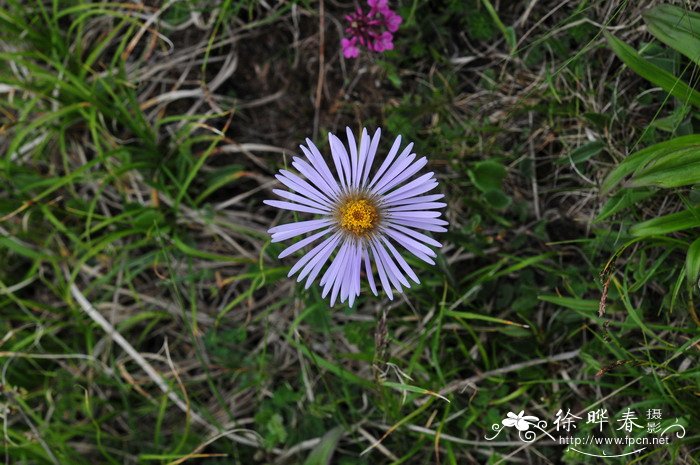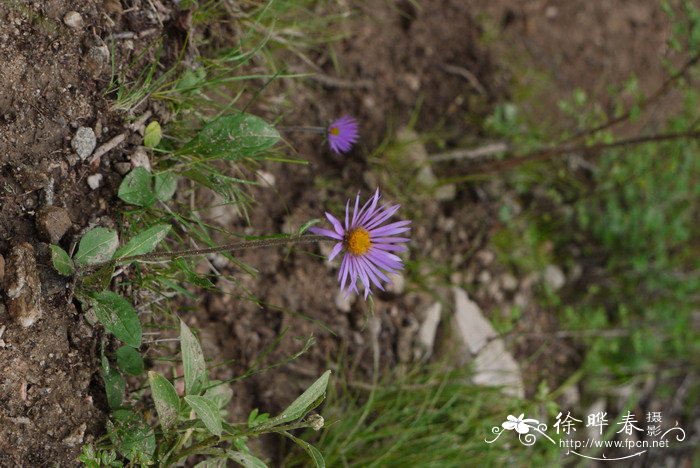萎软紫菀Aster flaccidus
中文名(Chinese Name):萎软紫菀
学名(Scientific Name):Aster flaccidus Bunge
英文名(English Common Name):
别名(Chinese Common Name):肺经草
异名(Synonym):Erigeron heterochaeta (Benth. ex C. B. Clarke) Botsch. Aster flaccidus f. griseobarbatus Grierson Aster flaccidus var. fructoglandulosus Ostenf.
科属(Family & Genus):菊科Compositae紫菀属Aster
形态特征(Description):多年生草本,根状茎细长,有时具匍枝。茎直立,高5-30稀达40厘米,不分枝,被皱曲或开展的长毛,上部常杂有具柄腺毛,或仅有腺毛或腺毛,下部有密集的叶。基部叶及莲座状叶匙形或长圆状匙形,长2-7厘米,宽0.5-2厘米,下部渐狭成短或长柄,顶端圆形或尖,边缘无齿或稀有少数浅齿,茎部叶3-5个,长圆形或长圆披针形,长3-7厘米,宽0.3-2厘米,基部渐狭或急狭,常半抱茎,上部叶小,线形;全部叶质薄,两面被密长毛或近无毛,或有腺;离基三出脉和侧脉细。头状花序在茎端单生,径3.5-5稀达7厘米。总苞半球形,径1.5-2稀达3厘米,被白色或深色长毛或有腺毛;总苞片2层,线状披针形,近等长,长0.7-10稀达12毫米,宽1.5-2稀2.2毫米,草质,顶端尖或渐尖,内层边缘狭膜质。舌状花40-60个,管部长2毫米,上部有短毛;舌片紫色,稀浅红色,长13-25稀达30毫米,宽1.5-2.5毫米。管状花黄色,长5.5-6.5毫米,管部长1.5-2.5毫米;裂片长约1毫米,被短毛;花柱附片长0.5-1.2毫米。冠毛白色,外层披针形,膜片状,长1.5毫米,内层有多数长6-7毫米的糙毛。瘦果长圆形,长2.5-3.5毫米,有2边肋,或一面另有一肋,被疏贴毛,或杂有腺毛,稀无毛。花果期6-11月。
分布(Distribution):广泛分布于我国北部、西北部、西部、西南部、新疆及西藏。也分布于喜马拉雅山区、中亚、蒙古及苏联西伯利亚东部。
用途(Use):全草治肺痈,肺结核,百日咳,目疾。
引自中国植物志英文版:FOC Vol. 20-21 Page 614, 626, 627, 628, 630
Aster flaccidus Bunge, Mém. Acad. Imp. Sci. Saint Pétersbourg, sér. 7. 2: 599. 1835.
萎软紫菀 wei ruan zi wan | Asteraceae | Aster
Herbs, perennial, 3-30(-40) cm tall, often scapiform; rhizome long, slender, sometimes stoloniferous. Stems erect, simple, white (sometimes purple) villous, more densely so upward (sometimes also basally), sparsely to densely minutely stipitate glandular. Leaves basal and cauline; cauline leaves reduced upward, thin, sparsely to moderately villous, sometimes glabrate, sparsely to moderately minutely stipitate glandular, margin entire or remotely serrulate (basal), ciliate, finely 3-veined; basal leaves present, sometimes withered or absent at anthesis, short or long (petiole to 7 cm) petiolate; blade spatulate to oblong to oblanceolate, 1-9.5 × 0.5-1.6 cm, base attenuate, apex rounded or obtuse to acute; cauline leaves usually sessile, oblong or oblong-lanceolate, 1.5-9 × 0.2-1.5 cm, base attenuate to cuneate or ± rounded, usually subclasping; upper cauline leaves lanceolate to lanceolate-linear. Capitula terminal, solitary, 3.5-5(-7) cm in diam.; peduncles sparsely to densely villous, sometimes more densely so below capitula, sparsely to densely glandular. Involucres hemispheric, (1.2-)1.5-2(-3) cm in diam.; phyllaries 2-seriate, subequal, lanceolate, 7-13 × 1-2 mm, abaxially basally densely white lanate to sparsely white villous, usually less so upward, sparsely to densely minutely stipitate glandular, margin scarious, sometimes purple tinged, ciliate, membranous, multiveined, apex acuminate, tip sometimes spreading, often densely villous. Ray florets 31-67, blue or mauve, lavender-blue, rarely pink or pinkish white, lamina linear-lanceolate, 9-25 × 1-2.5 mm, abaxially proximally hairy (crosswalls purple) or glabrous, eglandular; disk florets orange to yellow, 4.5-7 mm, limb funnelform, 3.5-5 mm, proximally sparsely hairy, lobes erect, triangular, 0.7-1.5 mm. Achenes brownish, narrowly obovoid, compressed, 2.5-3.5 mm, sparsely strigillose, sparsely to moderately (apically) minutely stipitate glandular, rarely glabrous and eglandular, margin strigillose-ciliate, 2-ribbed, ribs pronounced. Pappus 4-seriate, whitish (sometimes purplish), bristles barbellate; outermost series of narrow scales 0.6-1.5 mm; outer bristles few, slender, 3.5-5 mm; inner bristles 6-6.5 mm, acute; innermost bristles 6.5-7.5 mm, weakly clavate. Fl. and fr. Jun-Nov. 2n = 54.
Damp alpine grasslands, alpine and subalpine pastures, meadows, thickets, screes, fallow fields, forests; 1800-5100 m. S Gansu, N Hebei, E Qinghai, S Shaanxi, Shanxi, W Sichuan, Xinjiang, Xizang, NW Yunnan [Afghanistan, Bhutan, India, Kashmir, Kazakhstan, Mongolia, Nepal, Pakistan, Russia (E Siberia), Uzbekistan; SW Asia (Iran)].
Aster flaccidus is used medicinally to treat pulmonary abscesses, tuberculosis, and pertussis.
Three forms have been recognized in China: Aster flaccidus f. flaccidus with leaves ± villous, stem apex and involucre base more densely white villous and inconspicuously glandular, involucres 1.5-2(-3) cm in diam.; A. flaccidus f. glabratus Y. Ling (Fl. Reipubl. Popularis Sin. 74: 239. 1985; NE Xizang) with leaf surfaces glabrous or sparsely villous on abaxial veins only, margin ciliate or not, involucres 2-2.5 cm in diam., phyllaries to 12 mm, abaxially or on veins villous, eglandular; and A. flaccidus f. griseobarbatus Grierson (Notes Roy. Bot. Gard. Edinburgh 26: 131. 1964; 3200-4900 m; S and E Xizang, NW Yunnan [Bhutan, NE India]) with upper stems and involucres purplish brown or gray-brown hairy.


(责任编辑:徐晔春)
学名(Scientific Name):Aster flaccidus Bunge
英文名(English Common Name):
别名(Chinese Common Name):肺经草
异名(Synonym):Erigeron heterochaeta (Benth. ex C. B. Clarke) Botsch. Aster flaccidus f. griseobarbatus Grierson Aster flaccidus var. fructoglandulosus Ostenf.
科属(Family & Genus):菊科Compositae紫菀属Aster
形态特征(Description):多年生草本,根状茎细长,有时具匍枝。茎直立,高5-30稀达40厘米,不分枝,被皱曲或开展的长毛,上部常杂有具柄腺毛,或仅有腺毛或腺毛,下部有密集的叶。基部叶及莲座状叶匙形或长圆状匙形,长2-7厘米,宽0.5-2厘米,下部渐狭成短或长柄,顶端圆形或尖,边缘无齿或稀有少数浅齿,茎部叶3-5个,长圆形或长圆披针形,长3-7厘米,宽0.3-2厘米,基部渐狭或急狭,常半抱茎,上部叶小,线形;全部叶质薄,两面被密长毛或近无毛,或有腺;离基三出脉和侧脉细。头状花序在茎端单生,径3.5-5稀达7厘米。总苞半球形,径1.5-2稀达3厘米,被白色或深色长毛或有腺毛;总苞片2层,线状披针形,近等长,长0.7-10稀达12毫米,宽1.5-2稀2.2毫米,草质,顶端尖或渐尖,内层边缘狭膜质。舌状花40-60个,管部长2毫米,上部有短毛;舌片紫色,稀浅红色,长13-25稀达30毫米,宽1.5-2.5毫米。管状花黄色,长5.5-6.5毫米,管部长1.5-2.5毫米;裂片长约1毫米,被短毛;花柱附片长0.5-1.2毫米。冠毛白色,外层披针形,膜片状,长1.5毫米,内层有多数长6-7毫米的糙毛。瘦果长圆形,长2.5-3.5毫米,有2边肋,或一面另有一肋,被疏贴毛,或杂有腺毛,稀无毛。花果期6-11月。
分布(Distribution):广泛分布于我国北部、西北部、西部、西南部、新疆及西藏。也分布于喜马拉雅山区、中亚、蒙古及苏联西伯利亚东部。
用途(Use):全草治肺痈,肺结核,百日咳,目疾。
引自中国植物志英文版:FOC Vol. 20-21 Page 614, 626, 627, 628, 630
Aster flaccidus Bunge, Mém. Acad. Imp. Sci. Saint Pétersbourg, sér. 7. 2: 599. 1835.
萎软紫菀 wei ruan zi wan | Asteraceae | Aster
Herbs, perennial, 3-30(-40) cm tall, often scapiform; rhizome long, slender, sometimes stoloniferous. Stems erect, simple, white (sometimes purple) villous, more densely so upward (sometimes also basally), sparsely to densely minutely stipitate glandular. Leaves basal and cauline; cauline leaves reduced upward, thin, sparsely to moderately villous, sometimes glabrate, sparsely to moderately minutely stipitate glandular, margin entire or remotely serrulate (basal), ciliate, finely 3-veined; basal leaves present, sometimes withered or absent at anthesis, short or long (petiole to 7 cm) petiolate; blade spatulate to oblong to oblanceolate, 1-9.5 × 0.5-1.6 cm, base attenuate, apex rounded or obtuse to acute; cauline leaves usually sessile, oblong or oblong-lanceolate, 1.5-9 × 0.2-1.5 cm, base attenuate to cuneate or ± rounded, usually subclasping; upper cauline leaves lanceolate to lanceolate-linear. Capitula terminal, solitary, 3.5-5(-7) cm in diam.; peduncles sparsely to densely villous, sometimes more densely so below capitula, sparsely to densely glandular. Involucres hemispheric, (1.2-)1.5-2(-3) cm in diam.; phyllaries 2-seriate, subequal, lanceolate, 7-13 × 1-2 mm, abaxially basally densely white lanate to sparsely white villous, usually less so upward, sparsely to densely minutely stipitate glandular, margin scarious, sometimes purple tinged, ciliate, membranous, multiveined, apex acuminate, tip sometimes spreading, often densely villous. Ray florets 31-67, blue or mauve, lavender-blue, rarely pink or pinkish white, lamina linear-lanceolate, 9-25 × 1-2.5 mm, abaxially proximally hairy (crosswalls purple) or glabrous, eglandular; disk florets orange to yellow, 4.5-7 mm, limb funnelform, 3.5-5 mm, proximally sparsely hairy, lobes erect, triangular, 0.7-1.5 mm. Achenes brownish, narrowly obovoid, compressed, 2.5-3.5 mm, sparsely strigillose, sparsely to moderately (apically) minutely stipitate glandular, rarely glabrous and eglandular, margin strigillose-ciliate, 2-ribbed, ribs pronounced. Pappus 4-seriate, whitish (sometimes purplish), bristles barbellate; outermost series of narrow scales 0.6-1.5 mm; outer bristles few, slender, 3.5-5 mm; inner bristles 6-6.5 mm, acute; innermost bristles 6.5-7.5 mm, weakly clavate. Fl. and fr. Jun-Nov. 2n = 54.
Damp alpine grasslands, alpine and subalpine pastures, meadows, thickets, screes, fallow fields, forests; 1800-5100 m. S Gansu, N Hebei, E Qinghai, S Shaanxi, Shanxi, W Sichuan, Xinjiang, Xizang, NW Yunnan [Afghanistan, Bhutan, India, Kashmir, Kazakhstan, Mongolia, Nepal, Pakistan, Russia (E Siberia), Uzbekistan; SW Asia (Iran)].
Aster flaccidus is used medicinally to treat pulmonary abscesses, tuberculosis, and pertussis.
Three forms have been recognized in China: Aster flaccidus f. flaccidus with leaves ± villous, stem apex and involucre base more densely white villous and inconspicuously glandular, involucres 1.5-2(-3) cm in diam.; A. flaccidus f. glabratus Y. Ling (Fl. Reipubl. Popularis Sin. 74: 239. 1985; NE Xizang) with leaf surfaces glabrous or sparsely villous on abaxial veins only, margin ciliate or not, involucres 2-2.5 cm in diam., phyllaries to 12 mm, abaxially or on veins villous, eglandular; and A. flaccidus f. griseobarbatus Grierson (Notes Roy. Bot. Gard. Edinburgh 26: 131. 1964; 3200-4900 m; S and E Xizang, NW Yunnan [Bhutan, NE India]) with upper stems and involucres purplish brown or gray-brown hairy.
(责任编辑:徐晔春)
踩一下[2]

顶一下[4]